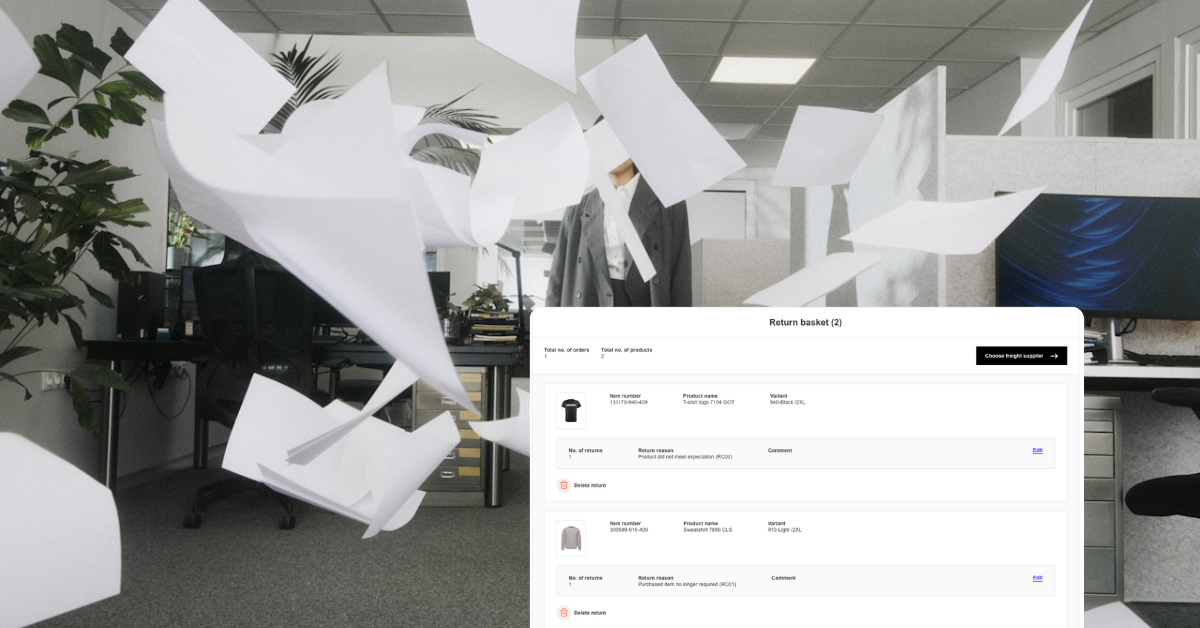5 thought experiments 2026
5 Five thought experiments to fix your returns before next peak Jennie Gerum December 2, 2025 6 min

Navigating the world of B2B returns is like walking a tightrope.
One misstep can lead to strained relationships, wasted resources, and a mountain of inefficiencies.
But it doesn’t have to be that way.
Let’s explore the key challenges of B2B returns and, more importantly, the tactics to overcome them.
In the B2B world, returns often aren’t straightforward.
A single return request can span across multiple orders, sometimes from different departments or locations.
This complexity can easily turn into a logistical nightmare if not handled properly.
Tactic: The solution you choose needs to be able to consolidate multiple orders into a single return process.
This is one of the single most important features your solution must have to solve the complexity of B2B returns.
Without it, you won’t be able to achieve the efficiency and cost savings you’re looking for.
By consolidating these orders, you streamline the workflow, reduce errors, and ensure that every item is accounted for and processed efficiently.
B2B returns are often manual.
And due to the sheer quantity involved, they become incredibly time-consuming, error-prone, and expensive.
From processing return requests to sorting and restocking items, these tasks are frequently handled with outdated, labor-intensive methods.
This not only slows down your return cycle but also ties up valuable resources, creating bottlenecks that impact overall efficiency.
These manual processes have long been a neglected area, often overlooked in the push for innovation in other parts of the business. However, as return volumes increase and customer expectations evolve, the need for improvement in this area becomes more critical than ever.
Tactic: Automate as much of the return process as possible. From generating return labels to tracking inventory, automation reduces errors, saves time, and frees up your team to focus on higher-value tasks.
By implementing solutions, you can streamline operations, reduce costs, and significantly enhance the speed and accuracy of your return process. This shift not only improves efficiency but also enhances the overall customer and partner experience, turning returns into a smoother, more reliable process.
Handling returns from outdated or faulty orders can drain your resources and clutter your warehouse.
No one wants to deal with products from ten seasons ago.
Tactic: You need a system that can block these returns even before they arrive—so they don’t end up in your warehouse and become your headache.
By preventing these items from being returned in the first place, you minimize the risk of deadstock or overstock cluttering your space.
This approach allows your team to focus on managing current, profitable items, keeping your inventory lean and your operations efficient.
Why return items to a central warehouse when a store across the city is in desperate need of them?
This inefficiency can lead to unnecessary shipping costs and delayed restocking.
Tactic: You need a solution that can automate this process for you.
Automatically redirect items to where the need or demand is highest, bypassing the middleman and reducing both costs and delays.
And hey—it’s a lot better for the environment too.
By optimizing the redirection of returns, you not only save time and money but also reduce your carbon footprint, making your business operations more sustainable.
B2B returns aren’t about a handful of items—they’re about pallets, crates, and containers.
These returns often come from different customers and third-party logistics (3PL) providers, all bulked together.
Despite being bulked, they often involve the same return types, which can create additional complexity. The sheer volume and the need to sort through these bulk returns can easily overwhelm traditional returns processes.
Without a system tailored to handle such large quantities, you risk bottlenecks, mismanagement, and significant delays.
These inefficiencies not only slow down your operations but also increase costs and strain your resources.
Tactic: To increase efficiency, you need a solution that can automate these processes and handle large quantities from multiple sources.
This includes prioritizing the right orders so that items become sellable as quickly as possible, ensuring that your inventory remains fluid and responsive to market demand.
Automation also helps maintain strong relationships with your partners by processing returns promptly and accurately, minimizing the impact on their operations.
By leveraging technology in this way, you can streamline bulk returns, reduce the risk of errors, and keep your business running smoothly.

Different countries, different rules.
B2B returns often involve navigating a labyrinth of international regulations, from varying warranty periods to customs issues.
The complexity doesn’t stop there.
Different agreements, different terms for different customers—like return policies and liability clauses—make B2B returns far more complex than the fairly standardized world of B2C.
Tactic: The solution you’re looking for needs to be able to navigate the legal landscape of B2B returns.
It must handle the varying terms and agreements across different customers and countries in an automated manner.
Without this capability, you risk non-compliance, delays, and increased costs.
By choosing a platform equipped to manage these complexities, your returns process remains compliant, efficient, and hassle-free, no matter where your customers are located.
Excess inventory is the silent killer of profitability.
B2B returns can lead to overstock or deadstock if not managed correctly.
Imagine receiving large quantities of unwanted items that end up on warehouse shelves, forgotten and useless. These could be products from old seasons, items with little demand, or seasonal goods like swimwear that linger after summer when customers have shifted their focus to winter clothes.
If these items are not properly managed, they can become deadstock, tying up valuable warehouse space and capital, and ultimately eating away at your bottom line.
Tactic: Implement a system that allows you to block and redirect returned items to the best available locations. Whether it’s sending them to a nearby store that needs them, redirecting to an outlet, donating to charity, or any other destination that maximizes their value, this approach ensures that no item sits idle in your warehouse, reducing the risk of overstock and deadstock while optimizing profitability.
B2B transactions are built on relationships.
One bad return experience can jeopardize a partnership that took years to cultivate.
Your returns process should reflect the value you place on these relationships.
Tactic: Establish a personalized return process for key partners. Provide dedicated support, tailor the process to their specific needs, and ensure transparent communication throughout. This proactive approach can turn a potential negative into an opportunity to strengthen the partnership.
Handling B2B returns is complex, but it doesn’t have to be a headache.
By implementing these key tactics, you can transform your returns process from a burden into a competitive advantage – saving you a lot of money!
Remember, the goal isn’t just to manage returns—it’s to do so in a way that strengthens your business relationships, protects your bottom line, and positions your brand as a leader in the industry.
Are you ready to take your B2B returns process to the next level?
Let’s get started.
5 Five thought experiments to fix your returns before next peak Jennie Gerum December 2, 2025 6 min

Why the fashion industry is solving the wrong problem New research reveals that the solution to rising return costs isn’t better fit - it’s better control. Fashion brands have spent years ...

The real profitability killer in e-commerce The real growth metric in 2025 isn’t sales, it’s profit after returns.And the real profitability killer in e-commerce? It’s not returns thems...